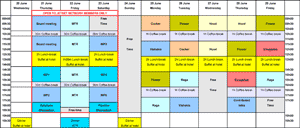
 From models to observations and experiments
25-29 June 2007, Azores, Portugal
From models to observations and experiments
25-29 June 2007, Azores, Portugal
Programme View the detailed timetable (click to enlarge):

Lectures Lab experiments (Rob Coker, LANL)
Sumary:
- scaling
- philosophopy behind the concept
- scaling the equations (and limitations thereof) for hydro, MHD & radiation
- the resulting relevant dimensionless parameters
- facilities and diagnostics
- a sketch of how to apply scaling to jets
- o protostellar jets (hydro)
- AGN (MHD)
Suggested reading (ordered):
Output from MHD models (Nektarios Vlahakis, Athens)Summary: - Introduction -- definitions -- MHD equations -- physics of integrals of steady-axisymmetric flows (relativistic and nonrelativistic)
- Momentum equation: acceleration and collimation mechanisms -- their relation to the streamline-shape and the current-distribution -- asymptotic analysis: expected flow-characteristics (velocity, flow-shape, magnetic field, density) -- relation with boundary conditions
- Brief discussion on the disk-outflow connection, and analytical/numerical disk models
- Semianalytical outflow models: results -- connection with previous analysis
- Outflow simulations: results -- connection with previous analysis
- Inflow-outflow simulations
- Open problems
Suggested reading (ordered):
MHD heating (Alan Hood, University of St Andrews)
Summary:
- An introduction to the Sun (for non solar physicists): description of solar phenomena, observations of photosphere, sunspots, convection, small scale magnetic fields, observations of the solar corona.
- Observational signatures of coronal heating: the energy budget and the contributions from various mechanisms (the theoretical ideas would be discussed later), the magnetic carpet.
- Theoretical ideas -- waves: MHD waves propagating in non-uniform plasmas, terminology (body, surface, kink, sausage and dispersion diagrams), observations of waves in the corona. Phase mixing, resonant absorption and observational differences.
- Theoretical ideas -- magnetic reconnection: basic ideas in reconnection theory, observations of reconnection, simulations of flux emergence (and heating), coronal tectonics (nanoflares).
- Theoretical ideas -- the plasma response: the plasma response to an input of heating.
- Recent observations from Hinode and Stereo: recent observations of sunspots, flares, prominences, small reconnection jets, CMEs, 3D movies of the Sun.
Suggested reading (ordered):
Flows in molecular media (David Flower, Durham)
Summary:
- Summary of flow equations in 1-D and in steady state, including a magnetic field: Discussion of the 'source' terms, which include the physical and chemical processes contributing to changes of number density, the momentum and energy fluxes, viz. chemical reactions, heating and cooling processes.
- J-type shock waves
- Jump (Rankine-Hugoniot) conditions
- Cooling processes behind the 'discontinuity'
- H_2 reformation behind the discontinuity
- C-type shock waves
- Importance of the magnetic field
- Significance of the chemistry
- Evolution of J- into C-type shocks: time-dependent MHD models
- Shock waves in diffuse interstellar gas: effects arising from the ultraviolet radiation field
- Diagnostics
- H_2 'excitation diagram'
- Comparison of the predictions of J- and C-type shocks
- Examples of specific outflow sources
- Forbidden lines, e.g. [C I], [N I], [S II] and [Fe II] : mechanism of their excitation
Suggested reading:
The ionisation and excitation state of stellar outflows (Alex Raga, UNAM)
Summary:
- Motivation: the gasdynamic description of an astrophysical flow
- The ionisation state of the gas
- ionisation equilibrium, non-equilibrium, statistical equilibrium, coronal equilibrium
- collisional ionisation, radiative+dielectronic recombination, charge exchange and photoionisation coefficients
- integrating the non-equilibrium ionisation rate equations: analytic examples and numerical methods
- The cooling function
- collisional ionisation, radiative recombination
- recombination lines
- collisionally excited lines (by electrons, by neutrals)
- The detailed calculation of emission lines
- the statistical equilibrium for the excited states: general problem
- collisionally excited lines, recombination lines
- the atomic parameters
- Optically thick continua and lines
- the radiative transfer problem
- optically thick radio continuum
- optically thick lines: escape probability, Sobolev approximation.
- Recipes for calculating the cooling function
- coronal equilibrium and isochoric cooling functions
- other parametrized and tabulated cooling functions
Required reading:
Suggested reading:
Inversion of observations (Catherine Dougados, LAOG)
Summary:
- Deriving model-independent excitation conditions for the atomic gas
- electronic density diagnostics
- temperature diagnostics
- BE99 technique: Te,xe from optical line ratios
- measure of Fe depletion and dust fraction in the jet
- limitations and uncertainties
- Derivation of excitation conditions from shock models
- indication for shock excitation in stellar jets
- derivation of npreshock, Vshock, Bshock
- Derivation of mass-loss rates
- from luminosity or from nH estimates
- under shock or volume emission
- comparison of the different methods
- Projection and convolution effects
- derivation of inclination angle and true space velocities
- measure of jet transverse widths: effects of the psf
- measure of jet rotation: true Vphi
- biases introduced on derived jet excitation conditions
Suggested reading:
|
 From models to observations and experiments
From models to observations and experiments























